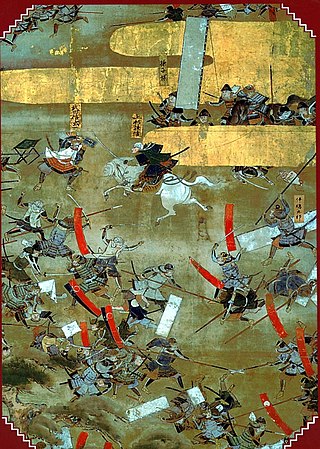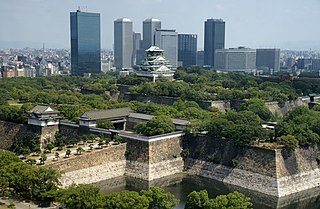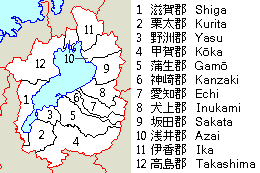
The Sengoku period is the period in Japanese history in which civil wars and social upheavals took place almost continuously in the 15th and 16th centuries. Though the Ōnin War (1467) is generally chosen as the Sengoku period's start date, there are many competing historiographies for its end date, ranging from 1568, the date of Oda Nobunaga's march on Kyoto, to the suppression of the Shimabara Rebellion in 1638, deep into what is traditionally considered the Edo period. Regardless of the dates chosen, the Sengoku period overlaps substantially with the Muromachi period (1336–1573).

Iga Province was a province of Japan located in what is today part of western Mie Prefecture. Its abbreviated name was Ishū (伊州). Iga is classified as one of the provinces of the Tōkaidō. Under the Engishiki classification system, Iga was ranked as an "inferior country" and a "near country".

The Ōnin War, also known as the Upheaval of Ōnin and Ōnin-Bunmei war, was a civil war that lasted from 1467 to 1477, during the Muromachi period in Japan. Ōnin refers to the Japanese era during which the war started; the war ended during the Bunmei era. A dispute between a high official, Hosokawa Katsumoto, and a regional lord, Yamana Sōzen, escalated into a nationwide civil war involving the Ashikaga shogunate and a number of daimyō in many regions of Japan.

Sōhei were Buddhist warrior monks of both classical and feudal Japan. At certain points in history, they held considerable power, obliging the imperial and military governments to collaborate.
Ikkō-ikki were rebellious or autonomous groups of people that were formed in several regions of Japan in the 15th-16th centuries; backed up by the power of the Jōdo Shinshū sect of Buddhism, they opposed the rule of governors or daimyō. Mainly consisting of priests, peasants, merchants and local lords who followed the sect, they sometimes associated with non-followers of the sect. They were at first organized to only a small degree; if any single person could be said to have had any influence over them it was Rennyo, the leader of the Jōdo Shinshū Hongan-ji sect at that time. Whilst he may have used the religious fervour of the Ikkō-ikki in the defence of his temple settlements, he was also careful to distance himself from the wider social rebellion of the Ikkō movement as a whole, and from offensive violence in particular.

The Ishiyama Hongan-ji (石山本願寺) was the primary fortress of the Ikkō-ikki, leagues of warrior priests and commoners who opposed samurai rule during the Sengoku period. It was established in 1496, at the mouth of the Yodo River, on the coast of the Seto Inland Sea. At the time, this was just outside the remains of the ancient capital of Naniwa, in Settsu Province. In fact, recent archaeological research has determined that the temple was established atop the ruins of the old imperial palace. The city has since grown around the site, incorporating the Ishiyama.

Kōsa, also known as Hongan-ji Kennyo, was the 11th head of the Hongan-ji in Kyoto, and Chief Abbot of Ishiyama Hongan-ji, cathedral fortress of the Ikkō-ikki, during its siege at the end of the Sengoku period. He engineered many alliances, and organized the defenses of the cathedral to the point that most at the time considered Ishiyama Hongan-ji to be unbreachable.
The jizamurai (地侍) were peasant-warriors that emerged in 15th-century Japan Muromachi period. They often used their relatively small plots of land for intensive and diversified forms of agriculture.

Air Gear is a Japanese manga series written and illustrated by Oh! great, serialized in Kodansha's shōnen manga magazine Weekly Shōnen Magazine from November 2002 to May 2012, with its chapters collected in 37 tankōbon volumes. Air Gear revolves around the life of Itsuki Minami "Ikki or Crow", also known as "Baby Face", "Lil Crow", and his friends. The story follows their use of Air Gear, an in-universe invention derived from inline skates. Initial sections of the plot carries out the introduction of characters that eventually join Ikki. As the story progresses, it focuses on their roles as Storm Riders and their quest to be on the top of the Trophaeum Tower, the pinnacle that all Storm Riders hope to reach.
The battle of Sendanno was a battle during the Sengoku period of Japan, one of many fought by daimyōs who sought to suppress the anti-samurai uprisings of the Ikkō-ikki. The Ikki were mobs of peasants, commoners, monks, and low-ranking samurai who revolted out of a desire to improve their social standing by threatening to overthrow the daimyo.

Total War: Shogun 2 is a strategy video game developed by Creative Assembly and published by Sega in 2011. It is the seventh mainline entry in the Total War series and returns to the setting of the first Total War game, Shogun: Total War, after a series of games set mainly in Europe and the Middle East.

The Kaga Rebellion or Chōkyō Uprising was a large-scale revolt in Kaga Province, Japan, in late 1487 through 1488. Togashi Masachika, who ruled Kaga Province as shugo, had been restored to power in 1473 with aid from the Asakura clan as well as the Ikkō-ikki, a loose collection of lesser nobility, monks, and farmers. By 1474, however, the Ikkō-ikki grew discontent with Masachika, and launched some initial revolts, which were easily quelled. In 1487, when Masachika left on a military campaign, between 100,000 and 200,000 Ikkō-ikki revolted. Masachika returned with his army, but the Ikkō-ikki, backed by several disaffected vassal families, overwhelmed his army and surrounded him in his palace, where he committed seppuku. The former vassals of Masachika granted the position of shugo to Masachika's uncle Yasutaka, but over the next several decades, the Ikkō-ikki increased their political hold on the province, eventually abolishing the shugo. They effectively controlled Kaga for almost a century.
Togashi Masachika was a general and daimyo in Japan during the Muromachi period. A member of the Togashi family, he ruled Kaga Province as shugo. When the Ōnin War broke out, Masachika sided with the Hosokawa clan, while his brother Kochiyo sided with Yamana clan. With the aid of Asakura clan and the Ikkō-ikki, Masachika defeated his brother and was restored to power. However, the Ikkō-ikki fell into dispute with Masachika, rising up in two failed revolts in 1474 and 1475. In late 1487, when Masachika left on a campaign to aid the shogun Ashikaga Yoshihisa, the Ikkō-ikki launched a massive revolt. Masachika returned to quell the rebellion, but was overwhelmed and cut off from any aid from the neighboring provinces. Besieged in his burning castle, he committed seppuku in 1488.

The Kaga ikki, also known as The Peasants' Kingdom, was a theocratic feudal confederacy that emerged in Kaga Province, Japan, during the late 15th and early 16th centuries. The Kaga ikki was a faction of the Ikkō-ikki, mobs of peasant farmers, monks, priests, and jizamurai that espoused belief in Jōdo Shinshū Buddhism. Though nominally under the authority of the head abbot of the Hongan-ji, the Monshu, the ikkō-ikki proved difficult to control.

Torigoe Castle was a Sengoku period yamashiro-style Japanese castle located in the Torigoe area of what is now part of the city of Hakusan, Ishikawa Prefecture in the Hokuriku region of Honshu, Japan. Its ruins have been protected as a National Historic Site since 1985. The National Historic Site consists of the ruins of two castles, Torigoe Castle and Futoge Castle. The two castles were built on two mountaintops with the Dainichi River between them in 1573 as the final bastions for the Kaga Ikkō-Ikki movement.

The Yamashiro ikki or Yamashiro kuni ikki was a confederacy that emerged in Japan's Yamashiro Province during the late 15th century. After the chaotic Ōnin War had weakened the Ashikaga shogunate's authority, feuding samurai armies fought for the control of provinces across Japan. In Yamashiro Province, local samurai and peasants formed an ikki league and rose up in 1485, successfully demanding the withdrawal of two rival warlord armies. The ikki members subsequently organized a new provincial government, defying both warlords as well as the Ashikaga shogun in nearby Kyoto. The Yamashiro ikki continued to operate until 1493, when a new invasion of samurai armies forced its members to reaccept the shogunate's authority. Regardless, Yamashiro Province remained largely under local control, and repeated local uprisings as well as protests continued until 1511.

The Iga ikki, full name Iga Sokoku Ikki, also known as the Iga Republic, Iga Confederacy, or Iga Commune, was a republic-style military confederation of ninjas based in Iga Province during the Sengoku period of Japan. One of the two major schools of ninjutsu, Iga-ryū, is attributed to, and takes its name, from this confederation. During the second half of the 15th century, the ninja families in Iga formed a military confederacy dedicated to the defense of the province. After centuries of rivalry with its northern neighbor, Kōka District in Ōmi Province, eventually Iga worked closely with in alliance with Kōka. In the 16th century, a constitution was drafted based on principles of mutual defense and voluntary association. The confederacy produced legendary figures such as Momochi Sandayu, Fujibayashi Nagato, Hattori Hanzō, Tateoka Doshun, and Shimotsuge no Kizaru. The activities of Iga eventually drew the ire of the Oda clan, who launched invasions in 1579 and 1581. The first invasion was decisively repelled by Iga, but the second overwhelmed the Iga forces and Oda Nobunaga viciously destroyed the confederation. Some ninja were spared and their activities allowed to continue. After Nobunaga's assassination in 1582, Iga and Kōka ninja, under the leadership of Hanzō, provided services to Nobunaga's ally Tokugawa Ieyasu and his descendants into the Tokugawa shogunate.

The Kōka ikki or Kōka Confederacy, historically known as the Kōka-gun Chūsō, was a military confederation and network of ninja in Kōka District in Southern Ōmi Province during the Sengoku period of Japan. Kōga-ryū, one of the two major traditions of ninjutsu, is named after the confederacy and attributes its origins to it. After centuries of rivalry with Iga Province to the south, eventually the district worked closely in alliance with Iga. It also frequently allied with the Rokkaku clan that controlled the portions of Southern Ōmi province immediately to the north. While in Iga the ninja families essentially gained control of the entire province in a de facto republic, Ōmi province was too large, diverse, and strategically valuable for the families in Kōka to project their control over the entire area. The independence of the confederation ended with the subjugation of Kōka in 1574 to the Oda clan. After that conquest, Kōka ninjas served Tokugawa Ieyasu and then his descendants late into the Edo period.
In the Sengoku period of Japan, the adjacent Iga ikki and Kōka ikki, self-governed military confederations of ninja families in the respective regions of Iga Province and Kōka District, frequently allied in mutual defense against outside military threats.











